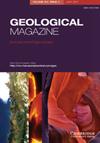来自德国莱茵山脉德鲁尔的密西西比系磷化微叠层石
IF 2
3区 地球科学
Q3 GEOSCIENCES, MULTIDISCIPLINARY
引用次数: 0
摘要
德鲁尔采石场位于莱茵河地块,是一个研究充分的露头,包括上泥盆统(法门统)至下石炭统(vissaman)地层。在Drewer矿床中,已经描述了两个黑色页岩层段,它们与两个全球海洋缺氧事件(Hangenberg事件和下明矾页岩事件)有关。利用薄片岩石学、粉末x射线衍射、傅里叶变换红外光谱和扫描电镜对中图尔纳世下明矾页岩事件相关的黑色页岩中含有丰富的磷结块进行了研究。这些固结物是在沉积物中缺氧和至少偶尔硫化物条件下的几个生长阶段形成的,并作为形成磷微叠层石的地下微生物垫的基质。微叠层石要么以部分分枝的柱体形式出现,长度可达600µm,要么以较小的球状聚集体形式出现,围绕在磷酸盐结块周围。元素图确定了磷化微叠层石中黄铁矿和其他金属硫化物的存在。磷化微叠层石中磷酸盐伴生碳酸盐的碳氧稳定同位素组成表明,形成垫层的微生物可能是下明矾页岩事件时期生活在缺氧环境中的厌氧化养微生物群落。这一解释与下明矾黑色页岩的深水沉积环境及其高有机质含量相一致,表明化养微生物席通常是产磷的有力媒介,特别是磷叠层石的形成。本文章由计算机程序翻译,如有差异,请以英文原文为准。
Chemotrophy-based phosphatic microstromatolites from the Mississippian at Drewer, Rhenish Massif, Germany
The Drewer quarry located in the Rhenish Massif is a well-studied outcrop that comprises Upper Devonian (Famennian) to Lower Carboniferous (Viséan) strata. Within the Drewer deposits two black shale intervals have been described that are linked to two global oceanic anoxic events, the Hangenberg Event and the Lower Alum Shale Event. The black shales associated with the Middle Tournaisian Lower Alum Shale Event contain abundant phosphatic concretions, which were investigated using thin section petrography, powder X-ray diffraction, Fourier-transform infrared spectrometry and scanning electron microscopy. The concretions formed during several growth phases under anoxic and at least episodically sulphidic conditions within the sediment and served as a substrate for subsurface microbial mats that formed phosphatic microstromatolites. The microstromatolites occur either as partially branched columns of up to 600 µm in length attached to the phosphatic concretions or as smaller, bulbous aggregates surrounding the concretions. Element mapping identified the presence of pyrite and other metal sulphides within the phosphatic microstromatolites. The carbon and oxygen stable isotopic composition of phosphate-associated carbonate within the phosphatic microstromatolites suggests that the mat-forming microorganisms were probably anaerobic, chemotrophic microbial communities dwelling in the anoxic environment during the Lower Alum Shale Event. Such interpretation agrees with the deeper-water depositional setting of the Lower Alum Black Shale and its high content of organic matter, suggesting that chemotrophic microbial mats are potent agents of phosphogenesis in general, and of the formation of phosphatic stromatolites in particular.
求助全文
通过发布文献求助,成功后即可免费获取论文全文。
去求助
来源期刊

Geological Magazine
地学-地球科学综合
CiteScore
4.70
自引率
0.00%
发文量
111
审稿时长
3 months
期刊介绍:
Geological Magazine, established in 1864, is one of the oldest and best-known periodicals in earth sciences. It publishes original scientific papers covering the complete spectrum of geological topics, with high quality illustrations. Its worldwide circulation and high production values, combined with Rapid Communications and Book Review sections keep the journal at the forefront of the field.
This journal is included in the Cambridge Journals open access initiative, Cambridge Open Option.
 求助内容:
求助内容: 应助结果提醒方式:
应助结果提醒方式:


